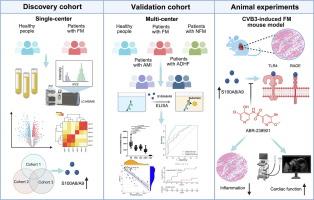当前位置:
X-MOL 学术
›
J. Adv. Res.
›
论文详情
Our official English website, www.x-mol.net, welcomes your
feedback! (Note: you will need to create a separate account there.)
Plasma proteomics identifies S100A8/A9 as a novel biomarker and therapeutic target for fulminant myocarditis
Journal of Advanced Research ( IF 11.4 ) Pub Date : 2025-06-04 , DOI: 10.1016/j.jare.2025.06.005
Wu He, Junfang Wu, Dongxue Wang, Wendong Chen, Yongcui Yan, Qiongyao He, Chenze Li, Qianying Yang, Chuanxi Huang, Zheng Wen, Chen Chen, Fuchu He, Liujun Tang, Dao Wen Wang
中文翻译:

血浆蛋白质组学将 S100A8/A9 确定为暴发性心肌炎的新型生物标志物和治疗靶点
暴发性心肌炎 (FM) 是一种致命的炎症性心肌疾病,其特征是进展迅速、预后不良。研究与 FM 相关的血浆蛋白可以阐明潜在的病理机制,确定新的生物标志物以在高危人群中进行早期检测,并推动靶向治疗策略的开发。
本研究旨在调查 FM 患者的蛋白质组学特征并确定潜在的生物标志物和治疗靶点,重点是 S100A8/S100A9。
我们对三个临床队列中来自 FM 患者的大量血浆样本采集进行了全面的蛋白质组学分析。我们的方法包括筛查与心功能不全和疾病严重程度相关的蛋白质。主要发现在一个独立的队列中得到了验证。同时,我们采用 CVB3 诱导的 FM 小鼠模型来评估这些生物标志物在心肌组织中的表达并评估靶向干预的效果。具体来说,我们研究了使用抑制剂 ABR-238901 阻断 S100A8/A9 异二聚体的治疗效果。
分析揭示了 FM 患者显着的先天免疫激活和严重的代谢紊乱。通过蛋白质组学分析和相关性分析,蛋白 S100A8 和 S100A9 成为与心功能不全和 FM 严重程度相关的重要生物标志物。S100A8/A9 异二聚体被验证为 FM 的关键诊断标志物,血浆水平升高与心源性死亡、心脏移植和心力衰竭或心肌炎住院率增加相关。在 CVB3 诱导的 FM 小鼠模型中,心肌组织显示 S100A8 和 S100A9 水平升高。ABR-238901 治疗通过缓解急性炎症和改善心脏功能显着降低死亡率。
S100A8/A9 成为 FM 的重要生物标志物和有前途的治疗靶点。这些发现为 FM 诊断提供了新的见解,并提出了潜在的干预策略。这些结果为进一步研究以验证 S100A8/A9 靶向治疗的临床应用铺平了道路,从而有可能改善患有这种严重心脏病的患者的预后。试用注册:ClinicalTrials.gov NCT03268642。
更新日期:2025-06-04
Journal of Advanced Research ( IF 11.4 ) Pub Date : 2025-06-04 , DOI: 10.1016/j.jare.2025.06.005
Wu He, Junfang Wu, Dongxue Wang, Wendong Chen, Yongcui Yan, Qiongyao He, Chenze Li, Qianying Yang, Chuanxi Huang, Zheng Wen, Chen Chen, Fuchu He, Liujun Tang, Dao Wen Wang

|
Introduction
Fulminant myocarditis (FM) is a lethal inflammatory myocardial disease characterized by rapid progression and poor prognosis. Investigating plasma proteins linked to FM may elucidate underlying pathological mechanisms, identify novel biomarkers for early detection in high-risk populations, and advance the development of targeted therapeutic strategies.Objectives
This study aimed to investigate the proteomic profiles of FM patients and identify potential biomarkers and therapeutic targets, focusing on S100A8/S100A9.Methods
We conducted a comprehensive proteomic analysis of an extensive plasma sample collection derived from FM patients across three clinical cohorts. Our approach included screening for proteins correlated with cardiac dysfunction and disease severity. Key findings were validated in an independent cohort. In parallel, we employed a CVB3-induced FM mouse model to evaluate the expression of these biomarkers in myocardial tissue and assess the effects of targeted interventions. Specifically, we investigated the therapeutic impacts of blocking the S100A8/A9 heterodimer using the inhibitor ABR-238901.Results
The analysis revealed significant innate immune activation and severe metabolic disturbances in FM patients. Through proteomic profiling and correlation analysis, proteins S100A8 and S100A9 emerged as significant biomarkers linked to cardiac dysfunction and FM severity. S100A8/A9 heterodimer was validated as a crucial diagnostic marker for FM, with elevated plasma levels correlating with increased rates of cardiac death, heart transplantation, and hospitalizations due to heart failure or myocarditis. In CVB3-induced FM mouse models, myocardial tissues showed increased levels of S100A8 and S100A9. Treatment with ABR-238901 significantly reduced mortality by alleviating acute inflammation and improving cardiac function.Conclusion
S100A8/A9 emerged as an essential biomarker and a promising therapeutic target for FM. These findings offer new insights into FM diagnosis and suggest potential intervention strategies. These results pave the way for further research to validate the clinical application of S100A8/A9-targeted therapies, potentially improving outcomes for patients suffering from this severe cardiac condition.Trial registration: ClinicalTrials.gov NCT03268642.中文翻译:

血浆蛋白质组学将 S100A8/A9 确定为暴发性心肌炎的新型生物标志物和治疗靶点
介绍
暴发性心肌炎 (FM) 是一种致命的炎症性心肌疾病,其特征是进展迅速、预后不良。研究与 FM 相关的血浆蛋白可以阐明潜在的病理机制,确定新的生物标志物以在高危人群中进行早期检测,并推动靶向治疗策略的开发。
目标
本研究旨在调查 FM 患者的蛋白质组学特征并确定潜在的生物标志物和治疗靶点,重点是 S100A8/S100A9。
方法
我们对三个临床队列中来自 FM 患者的大量血浆样本采集进行了全面的蛋白质组学分析。我们的方法包括筛查与心功能不全和疾病严重程度相关的蛋白质。主要发现在一个独立的队列中得到了验证。同时,我们采用 CVB3 诱导的 FM 小鼠模型来评估这些生物标志物在心肌组织中的表达并评估靶向干预的效果。具体来说,我们研究了使用抑制剂 ABR-238901 阻断 S100A8/A9 异二聚体的治疗效果。
结果
分析揭示了 FM 患者显着的先天免疫激活和严重的代谢紊乱。通过蛋白质组学分析和相关性分析,蛋白 S100A8 和 S100A9 成为与心功能不全和 FM 严重程度相关的重要生物标志物。S100A8/A9 异二聚体被验证为 FM 的关键诊断标志物,血浆水平升高与心源性死亡、心脏移植和心力衰竭或心肌炎住院率增加相关。在 CVB3 诱导的 FM 小鼠模型中,心肌组织显示 S100A8 和 S100A9 水平升高。ABR-238901 治疗通过缓解急性炎症和改善心脏功能显着降低死亡率。
结论
S100A8/A9 成为 FM 的重要生物标志物和有前途的治疗靶点。这些发现为 FM 诊断提供了新的见解,并提出了潜在的干预策略。这些结果为进一步研究以验证 S100A8/A9 靶向治疗的临床应用铺平了道路,从而有可能改善患有这种严重心脏病的患者的预后。试用注册:ClinicalTrials.gov NCT03268642。


















































 京公网安备 11010802027423号
京公网安备 11010802027423号